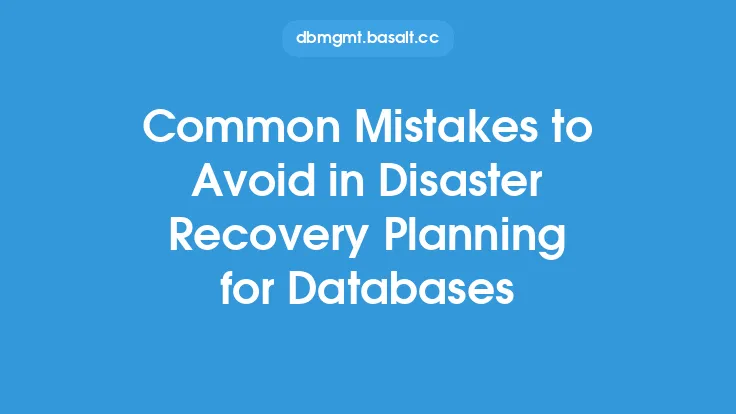When it comes to database capacity planning, there are several common mistakes that can have a significant impact on the performance and efficiency of a database. These mistakes can lead to a range of issues, from slow query times and data loss to system crashes and downtime. In this article, we will explore some of the most common mistakes to avoid in database capacity planning, and provide guidance on how to avoid them.
Introduction to Database Capacity Planning Mistakes
Database capacity planning is a critical process that involves predicting and preparing for the future storage and performance needs of a database. It requires a deep understanding of the database's current and future requirements, as well as the ability to anticipate and plan for potential issues. One of the most common mistakes made in database capacity planning is underestimating the amount of storage needed. This can lead to a range of issues, including slow query times, data loss, and system crashes. To avoid this mistake, it is essential to carefully monitor database growth and plan for future storage needs.
Inadequate Monitoring and Analysis
Inadequate monitoring and analysis is another common mistake made in database capacity planning. This can lead to a lack of understanding of the database's current and future needs, making it difficult to plan for potential issues. To avoid this mistake, it is essential to implement a comprehensive monitoring and analysis program that tracks key performance indicators (KPIs) such as storage usage, query times, and system performance. This will provide a clear understanding of the database's current and future needs, and enable proactive planning and optimization.
Insufficient Testing and Validation
Insufficient testing and validation is another common mistake made in database capacity planning. This can lead to a range of issues, including poor performance, data loss, and system crashes. To avoid this mistake, it is essential to thoroughly test and validate all database changes and upgrades before they are implemented in production. This includes testing for performance, scalability, and reliability, as well as validating data integrity and consistency.
Failure to Consider Data Growth and Distribution
Failure to consider data growth and distribution is another common mistake made in database capacity planning. This can lead to a range of issues, including slow query times, data loss, and system crashes. To avoid this mistake, it is essential to carefully consider data growth and distribution when planning for database capacity. This includes understanding the types of data being stored, the rate of data growth, and the distribution of data across the database.
Inadequate Planning for Peak Demand
Inadequate planning for peak demand is another common mistake made in database capacity planning. This can lead to a range of issues, including slow query times, data loss, and system crashes. To avoid this mistake, it is essential to carefully plan for peak demand periods, such as holidays or special events. This includes understanding the types of queries being executed, the volume of queries, and the resources required to support peak demand.
Failure to Consider Database Fragmentation
Failure to consider database fragmentation is another common mistake made in database capacity planning. Database fragmentation occurs when data is broken into smaller pieces and stored in non-contiguous locations on disk. This can lead to a range of issues, including slow query times, data loss, and system crashes. To avoid this mistake, it is essential to regularly monitor and maintain database fragmentation, using techniques such as defragmentation and reorganization.
Inadequate Planning for Database Upgrades and Migrations
Inadequate planning for database upgrades and migrations is another common mistake made in database capacity planning. This can lead to a range of issues, including downtime, data loss, and system crashes. To avoid this mistake, it is essential to carefully plan for database upgrades and migrations, including testing and validation, data backup and recovery, and resource allocation.
Failure to Consider Security and Compliance
Failure to consider security and compliance is another common mistake made in database capacity planning. This can lead to a range of issues, including data breaches, fines, and reputational damage. To avoid this mistake, it is essential to carefully consider security and compliance when planning for database capacity, including understanding regulatory requirements, implementing security controls, and monitoring for potential threats.
Best Practices for Avoiding Common Mistakes
To avoid the common mistakes outlined in this article, it is essential to follow best practices for database capacity planning. This includes regularly monitoring and analyzing database performance, testing and validating all database changes and upgrades, and carefully planning for future storage and performance needs. Additionally, it is essential to consider data growth and distribution, peak demand, database fragmentation, and security and compliance when planning for database capacity.
Conclusion
In conclusion, database capacity planning is a critical process that requires careful planning and attention to detail. By avoiding common mistakes such as underestimating storage needs, inadequate monitoring and analysis, and insufficient testing and validation, database administrators can ensure that their databases are properly optimized for performance and efficiency. By following best practices and carefully considering data growth and distribution, peak demand, database fragmentation, and security and compliance, database administrators can ensure that their databases are able to meet the needs of their organizations, both now and in the future.





